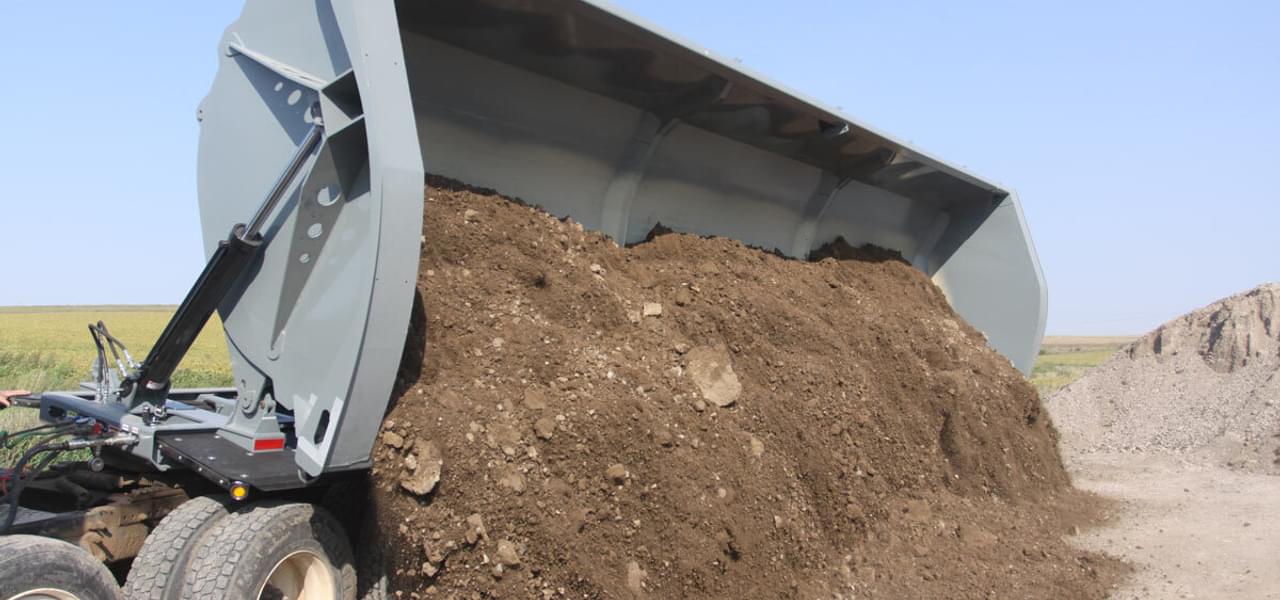
It doesn’t take much searching on YouTube to find videos of dump trucks tipping over. These videos tend to have one thing in common: the types of trailers they show tipping over are end dumps. A side dump trailer’s stability helps prevent this dangerous issue, so side dump operators can be more confident they won’t become accidental YouTube stars.
The founder of SmithCo, Greg Smith, was driven to create a side dump trailer because he owned a trucking company that used end dumps. After the company had multiple tip overs while hauling rip rap due to the large rocks becoming wedged in the end dump boxes, Greg’s insurance agent gave him two choices: stop trucking, or find a different kind of trailer. That’s how our side dump concept was born.
To understand why end dump trailers so commonly have tip over problems – and why the stability of side dumps is superior – it’s important to know the basics of how these trailers dump their loads.
How an End Dump Trailer Unloads
The process to unload an end dump trailer varies depending on the trailer style. There are three main types of end dumps: full frame, quarter frame and frameless, and each type has multiple choices of suspensions.
The specific combination of trailer style and suspension determines the process that must be used when unloading, but to illustrate one example, let’s look at the steps to unload a frameless end dump trailer equipped with an air ride tandem suspension:
1. The driver backs the tractor and trailer up to the location where the load is to be placed, making sure that the tractor and trailer are as straight with each other as possible. This is necessary because the trailer will have to be pulled forward with the body raised, and pulling sideways will make it very unstable.
2. Once the trailer is in position, the operator needs to deflate its air ride suspension. This is done to keep the air bags from extending as the load slides out, which would make things unstable. It may be necessary to deflate the tractor air bags as well.
On this step, it is always a good idea to check the surrounding area to ensure that the ground is as flat and firm as possible. Any lean or sinking of the trailer tires while dumping and moving forward will cause the top of the dump body to sway, and can result in a tip over.
3. Depending on the style of end gate the trailer is equipped with, it may be necessary to move mud flaps out of the way to avoid damage while dumping. If the trailer has a barn-door style end gate, it will need to be unlatched, swung around to the other side of the body, and secured into place. This can be a dangerous process because material in the body can shift and fall out, possibly injuring the operator.
4. It’s important to note that when the dump body is raised only the rear axle will be on the ground. When raising the dump body, the driver will have to control the forward motion of the tractor and trailer. This motion can vary depending on the material being hauled and the ground conditions. When dumping on a hard surface, the driver may have to feather the brakes to keep the truck and trailer from being pushed forward too quickly; if the same unit is dumping on a softer surface the driver will have to pull the trailer forward with the tractor.
End dump trailers are the most unstable during dumping. If the load hangs up towards the front of the body, the high center of gravity can easily cause a tip over. Additionally, if the tires on one side sink into softer soil, the trailer will shift to one side.
5. Once the payload is out, the operator must bring the body down. To do this, the trailer brakes should be set to prevent the rear of the trailer from moving backwards into the pile behind it. The truck will be moving forward at this time. After lowering the body, the operator must close the end gate, put mud flaps back to their normal position, and re-inflate the air ride suspension.
Why Side Dump Trailers Offer More Stability
Unlike the process described above for an end dump trailer, unloading a standard side dump trailer is much simpler. It’s not usually necessary to back the trailer up to position the load. Drivers can drive right next where the load needs to be placed, engage the power take-off (PTO), and start the dump cycle.
There is no need to get out to reposition mud flaps or open the end gates, and if the trailer has an air ride suspension, the bags remain inflated the entire time. Side dumps do not need to have the air bags deflated. After dumping the payload, the driver returns the tub to the normal position and heads out for the next load. This greater simplicity means it takes much less time to dump a side dump versus an end dump, which results in greater productivity.
Stability with Different Load Types
In addition to the way the trailer operates, the type of material being hauled can affect a trailer’s stability. Any material that compacts and sticks to the dump body can cause a tip over. And, as Greg Smith knew well, larger material like concrete breakout, rip rap, demolition or scrap steel can also get hung up in the body.
Side dumps have an advantage with materials that might otherwise cause poor stability, as materials discharge out of side dumps much better than end dumps. Materials simply don’t get hung up like they can in end dumps, which creates a more stable trailer.
If you have specific questions about how the stability of a side dump will suit your application, call us today at 800-779-8099.
How to Unload a Trailer
| Side Dump Trailer | Frameless End Dump Trailer with Air Ride Tandem Suspension |
| Position trailer alongside the dump site. | Back up to position the load, making sure that the tractor and trailer are as straight as possible. |
| Engage PTO. | Ensure ground is flat and firm. |
| Dump load. | Deflate air ride suspension, and if necessary, tractor air bags. |
| Return tub to upright position. | Move mud flaps. |
| Unlatch and secure end gate. | |
| Dump load by raising dump body, controlling the forward motion of the tractor and trailer. | |
| Set trailer brakes and bring body back down. | |
| Close end gate. | |
| Put mud flaps back to normal position. | |
| Re-inflate air ride suspension. |
